FIN-812930: Budgeting and Financial Analysis for Restaurant
VerifiedAdded on 2023/06/03
|11
|1800
|98
Report
AI Summary
This report presents a turnaround plan for a small restaurant in Northern Melbourne that has recently incurred financial losses. The plan begins with an analysis of the restaurant's current financial position, highlighting issues such as low gross margins due to high costs of goods sold, excessive salaries and wages, and a lack of student discounts and delivery services. The proposed turnaround strategy includes increasing sales by targeting the nearby student population with discounts and delivery options, improving gross margins by sourcing produce from local vendors, reducing salary expenses through better shift management and staff optimization, and closely monitoring monthly expenses and revenues. The plan sets specific targets for revenue growth, cost reduction, and profit improvement, with the goal of achieving profitability in the second half of the financial year through diligent implementation and monitoring of the suggested changes. Desklib provides access to similar solved assignments and past papers for students.

FIN-812930
Secure Best Marks with AI Grader
Need help grading? Try our AI Grader for instant feedback on your assignments.
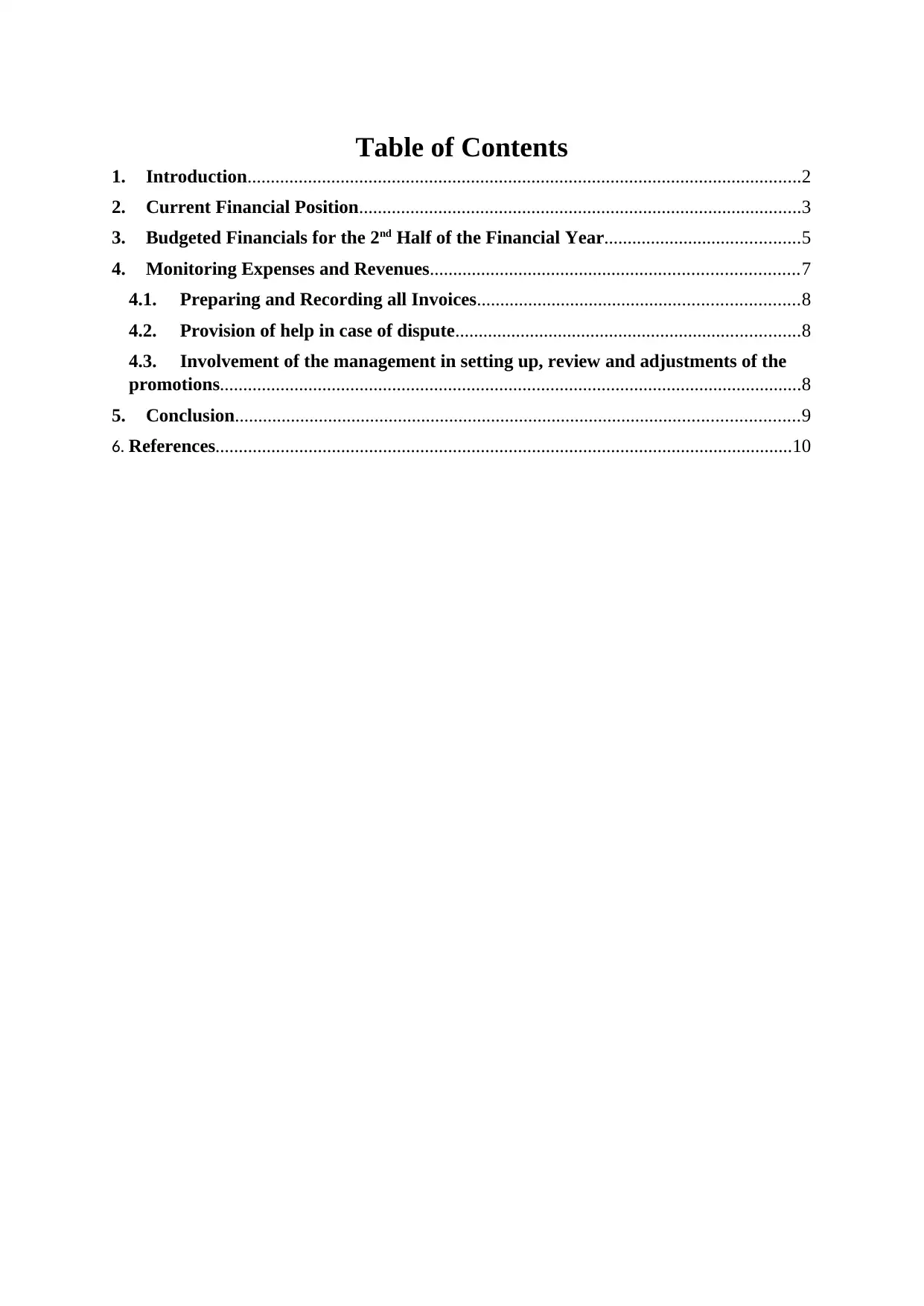
Table of Contents
1. Introduction.......................................................................................................................2
2. Current Financial Position...............................................................................................3
3. Budgeted Financials for the 2nd Half of the Financial Year..........................................5
4. Monitoring Expenses and Revenues...............................................................................7
4.1. Preparing and Recording all Invoices.....................................................................8
4.2. Provision of help in case of dispute..........................................................................8
4.3. Involvement of the management in setting up, review and adjustments of the
promotions.............................................................................................................................8
5. Conclusion.........................................................................................................................9
6. References............................................................................................................................10
1. Introduction.......................................................................................................................2
2. Current Financial Position...............................................................................................3
3. Budgeted Financials for the 2nd Half of the Financial Year..........................................5
4. Monitoring Expenses and Revenues...............................................................................7
4.1. Preparing and Recording all Invoices.....................................................................8
4.2. Provision of help in case of dispute..........................................................................8
4.3. Involvement of the management in setting up, review and adjustments of the
promotions.............................................................................................................................8
5. Conclusion.........................................................................................................................9
6. References............................................................................................................................10

1. Introduction
This report examines and analyses a small sized business involved in the business, which is a
small restaurant located in Northern Melbourne. The company has recently released its half-
yearly financial report, and it has been witnessed that the company has incurred a loss.
The owners of the business are not happy about incurring losses and have hired us to turn
around the business to ensure the business achieves profitability in the second half the
financial year.
This report contains a brief turnaround plan for the business which examines the reason of
losses incurred, prepares a plan to increase revenues and reduce cost and sets a target for the
managers and the management of the business to achieve to become profitable in the second
half of the financial year.
This report examines and analyses a small sized business involved in the business, which is a
small restaurant located in Northern Melbourne. The company has recently released its half-
yearly financial report, and it has been witnessed that the company has incurred a loss.
The owners of the business are not happy about incurring losses and have hired us to turn
around the business to ensure the business achieves profitability in the second half the
financial year.
This report contains a brief turnaround plan for the business which examines the reason of
losses incurred, prepares a plan to increase revenues and reduce cost and sets a target for the
managers and the management of the business to achieve to become profitable in the second
half of the financial year.
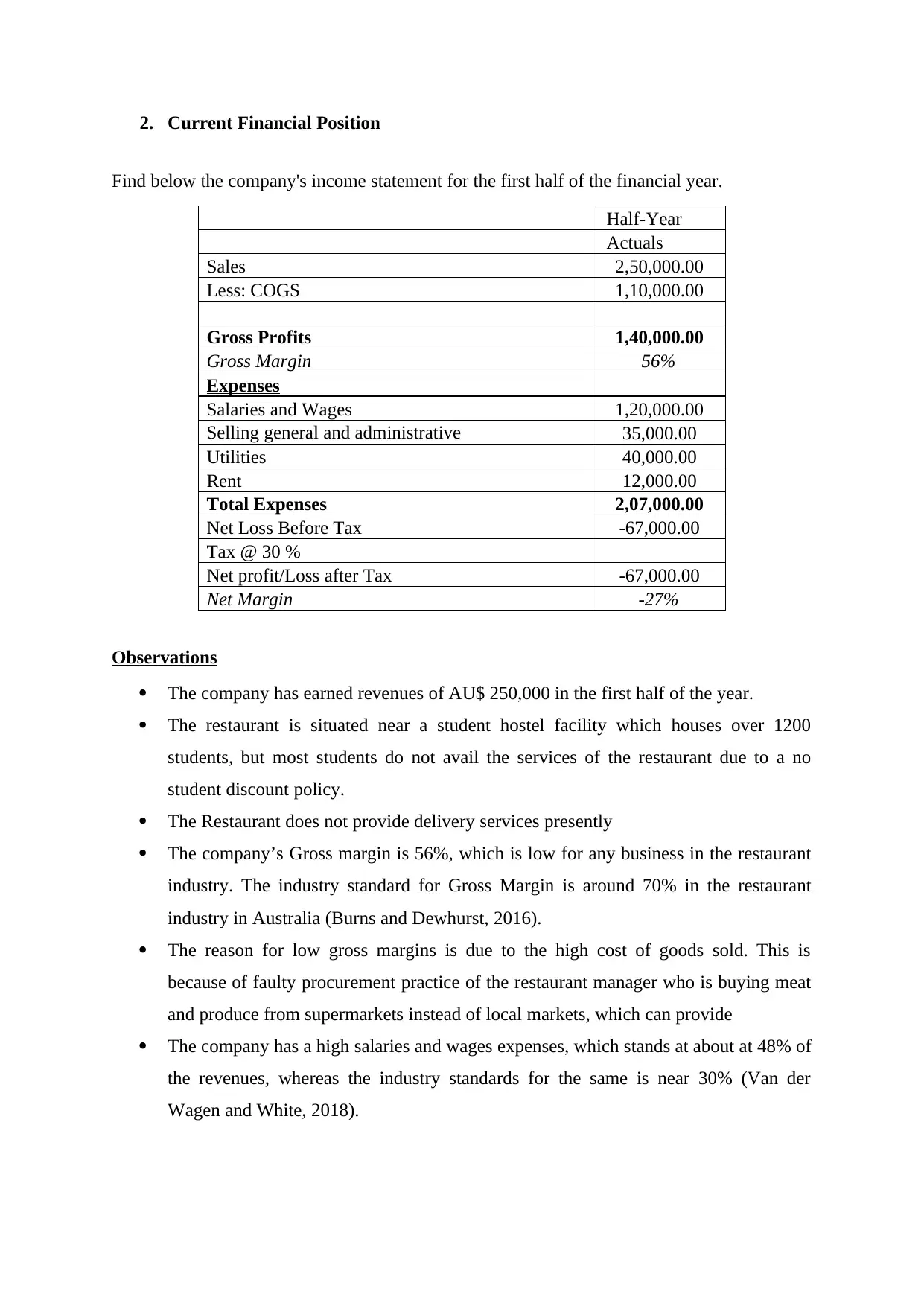
2. Current Financial Position
Find below the company's income statement for the first half of the financial year.
Half-Year
Actuals
Sales 2,50,000.00
Less: COGS 1,10,000.00
Gross Profits 1,40,000.00
Gross Margin 56%
Expenses
Salaries and Wages 1,20,000.00
Selling general and administrative 35,000.00
Utilities 40,000.00
Rent 12,000.00
Total Expenses 2,07,000.00
Net Loss Before Tax -67,000.00
Tax @ 30 %
Net profit/Loss after Tax -67,000.00
Net Margin -27%
Observations
The company has earned revenues of AU$ 250,000 in the first half of the year.
The restaurant is situated near a student hostel facility which houses over 1200
students, but most students do not avail the services of the restaurant due to a no
student discount policy.
The Restaurant does not provide delivery services presently
The company’s Gross margin is 56%, which is low for any business in the restaurant
industry. The industry standard for Gross Margin is around 70% in the restaurant
industry in Australia (Burns and Dewhurst, 2016).
The reason for low gross margins is due to the high cost of goods sold. This is
because of faulty procurement practice of the restaurant manager who is buying meat
and produce from supermarkets instead of local markets, which can provide
The company has a high salaries and wages expenses, which stands at about at 48% of
the revenues, whereas the industry standards for the same is near 30% (Van der
Wagen and White, 2018).
Find below the company's income statement for the first half of the financial year.
Half-Year
Actuals
Sales 2,50,000.00
Less: COGS 1,10,000.00
Gross Profits 1,40,000.00
Gross Margin 56%
Expenses
Salaries and Wages 1,20,000.00
Selling general and administrative 35,000.00
Utilities 40,000.00
Rent 12,000.00
Total Expenses 2,07,000.00
Net Loss Before Tax -67,000.00
Tax @ 30 %
Net profit/Loss after Tax -67,000.00
Net Margin -27%
Observations
The company has earned revenues of AU$ 250,000 in the first half of the year.
The restaurant is situated near a student hostel facility which houses over 1200
students, but most students do not avail the services of the restaurant due to a no
student discount policy.
The Restaurant does not provide delivery services presently
The company’s Gross margin is 56%, which is low for any business in the restaurant
industry. The industry standard for Gross Margin is around 70% in the restaurant
industry in Australia (Burns and Dewhurst, 2016).
The reason for low gross margins is due to the high cost of goods sold. This is
because of faulty procurement practice of the restaurant manager who is buying meat
and produce from supermarkets instead of local markets, which can provide
The company has a high salaries and wages expenses, which stands at about at 48% of
the revenues, whereas the industry standards for the same is near 30% (Van der
Wagen and White, 2018).
Secure Best Marks with AI Grader
Need help grading? Try our AI Grader for instant feedback on your assignments.
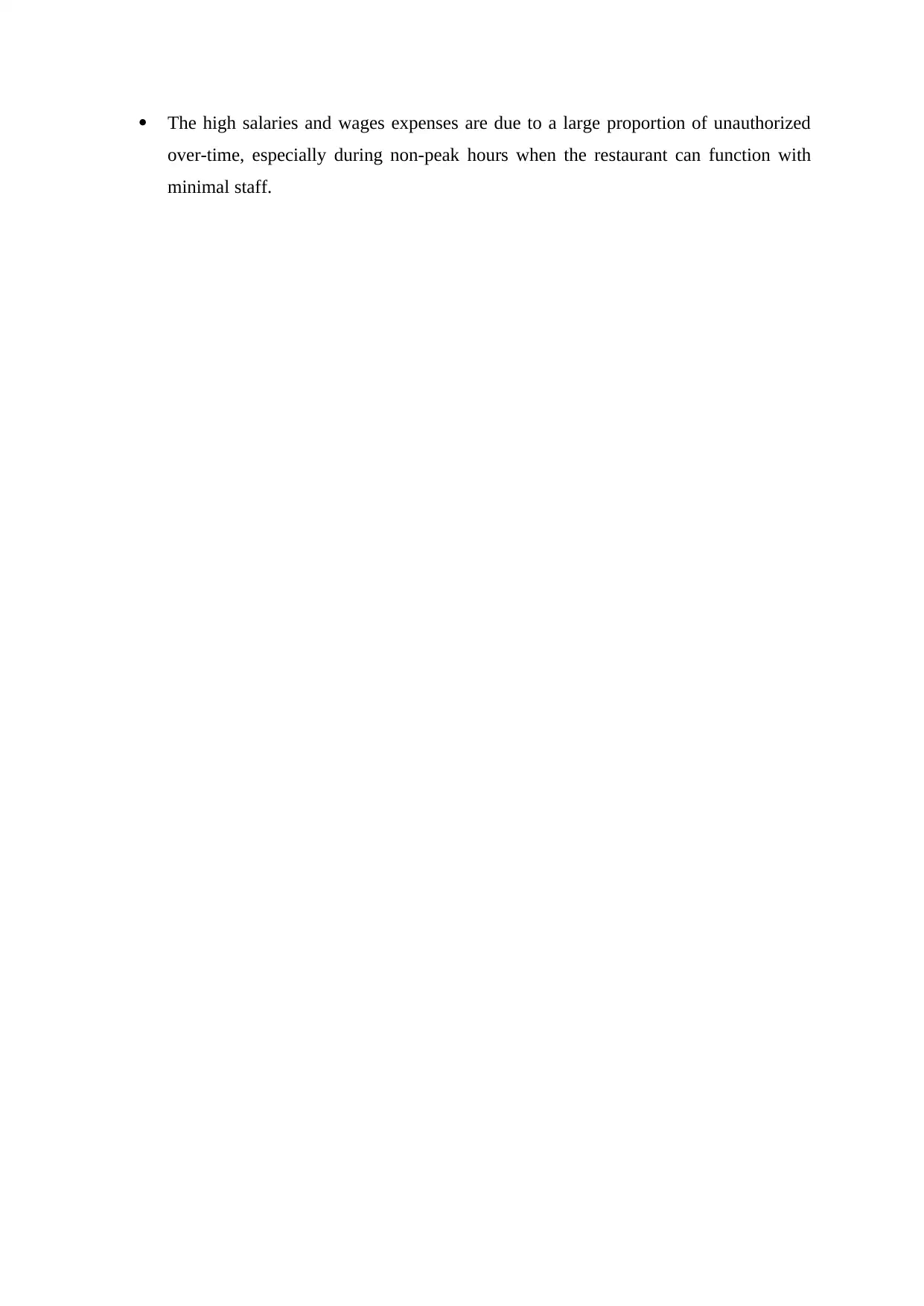
The high salaries and wages expenses are due to a large proportion of unauthorized
over-time, especially during non-peak hours when the restaurant can function with
minimal staff.
over-time, especially during non-peak hours when the restaurant can function with
minimal staff.
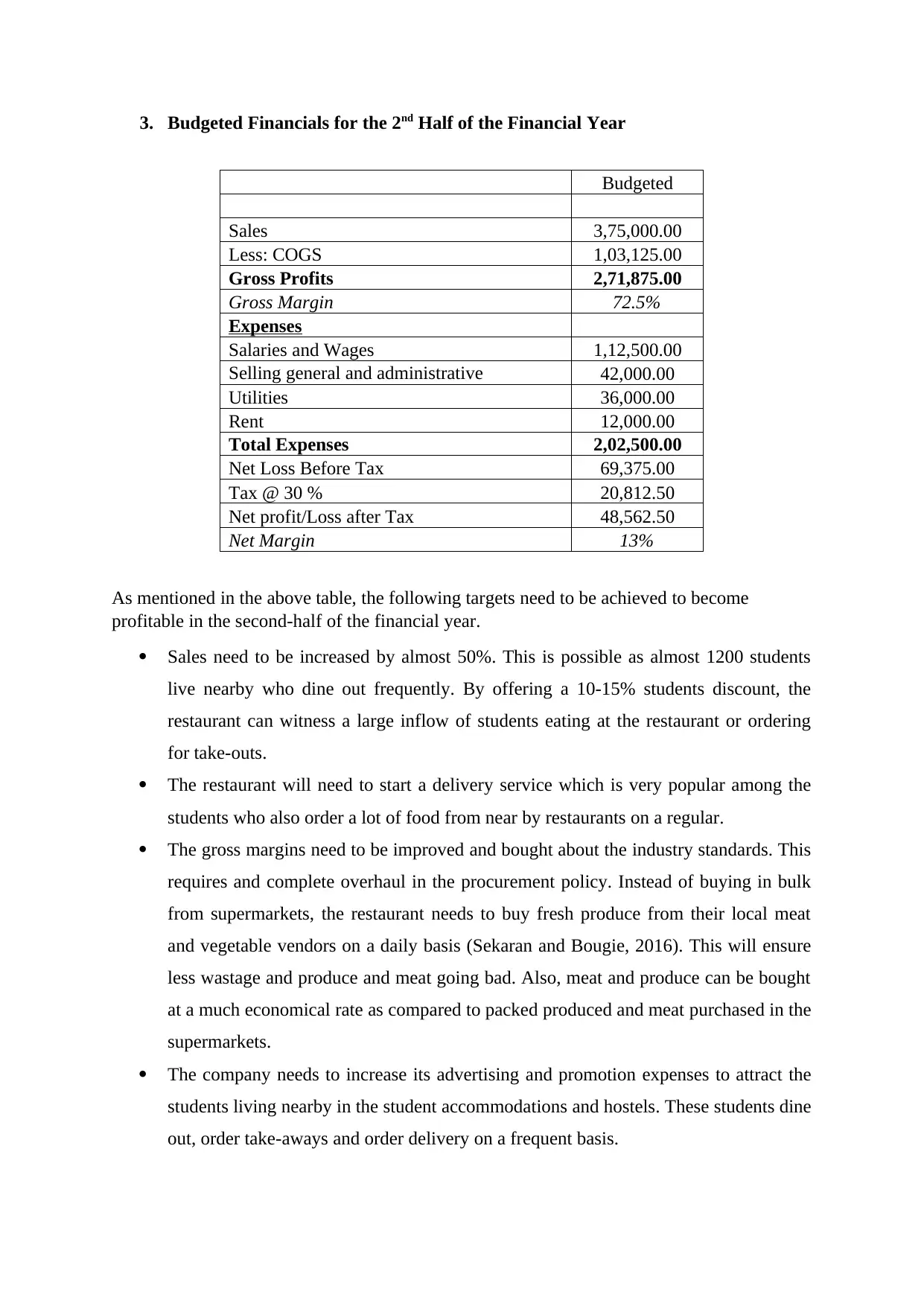
3. Budgeted Financials for the 2nd Half of the Financial Year
Budgeted
Sales 3,75,000.00
Less: COGS 1,03,125.00
Gross Profits 2,71,875.00
Gross Margin 72.5%
Expenses
Salaries and Wages 1,12,500.00
Selling general and administrative 42,000.00
Utilities 36,000.00
Rent 12,000.00
Total Expenses 2,02,500.00
Net Loss Before Tax 69,375.00
Tax @ 30 % 20,812.50
Net profit/Loss after Tax 48,562.50
Net Margin 13%
As mentioned in the above table, the following targets need to be achieved to become
profitable in the second-half of the financial year.
Sales need to be increased by almost 50%. This is possible as almost 1200 students
live nearby who dine out frequently. By offering a 10-15% students discount, the
restaurant can witness a large inflow of students eating at the restaurant or ordering
for take-outs.
The restaurant will need to start a delivery service which is very popular among the
students who also order a lot of food from near by restaurants on a regular.
The gross margins need to be improved and bought about the industry standards. This
requires and complete overhaul in the procurement policy. Instead of buying in bulk
from supermarkets, the restaurant needs to buy fresh produce from their local meat
and vegetable vendors on a daily basis (Sekaran and Bougie, 2016). This will ensure
less wastage and produce and meat going bad. Also, meat and produce can be bought
at a much economical rate as compared to packed produced and meat purchased in the
supermarkets.
The company needs to increase its advertising and promotion expenses to attract the
students living nearby in the student accommodations and hostels. These students dine
out, order take-aways and order delivery on a frequent basis.
Budgeted
Sales 3,75,000.00
Less: COGS 1,03,125.00
Gross Profits 2,71,875.00
Gross Margin 72.5%
Expenses
Salaries and Wages 1,12,500.00
Selling general and administrative 42,000.00
Utilities 36,000.00
Rent 12,000.00
Total Expenses 2,02,500.00
Net Loss Before Tax 69,375.00
Tax @ 30 % 20,812.50
Net profit/Loss after Tax 48,562.50
Net Margin 13%
As mentioned in the above table, the following targets need to be achieved to become
profitable in the second-half of the financial year.
Sales need to be increased by almost 50%. This is possible as almost 1200 students
live nearby who dine out frequently. By offering a 10-15% students discount, the
restaurant can witness a large inflow of students eating at the restaurant or ordering
for take-outs.
The restaurant will need to start a delivery service which is very popular among the
students who also order a lot of food from near by restaurants on a regular.
The gross margins need to be improved and bought about the industry standards. This
requires and complete overhaul in the procurement policy. Instead of buying in bulk
from supermarkets, the restaurant needs to buy fresh produce from their local meat
and vegetable vendors on a daily basis (Sekaran and Bougie, 2016). This will ensure
less wastage and produce and meat going bad. Also, meat and produce can be bought
at a much economical rate as compared to packed produced and meat purchased in the
supermarkets.
The company needs to increase its advertising and promotion expenses to attract the
students living nearby in the student accommodations and hostels. These students dine
out, order take-aways and order delivery on a frequent basis.
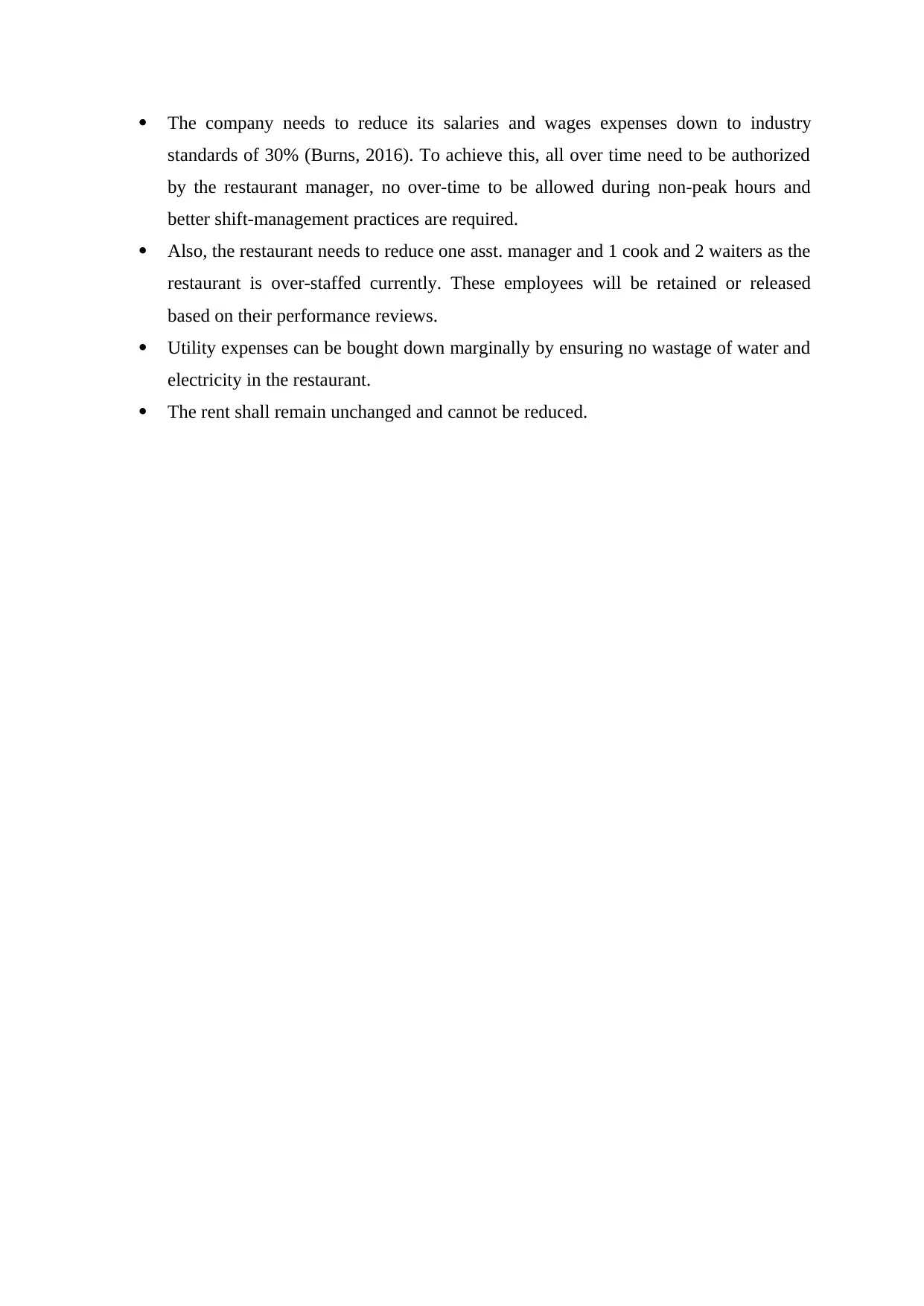
The company needs to reduce its salaries and wages expenses down to industry
standards of 30% (Burns, 2016). To achieve this, all over time need to be authorized
by the restaurant manager, no over-time to be allowed during non-peak hours and
better shift-management practices are required.
Also, the restaurant needs to reduce one asst. manager and 1 cook and 2 waiters as the
restaurant is over-staffed currently. These employees will be retained or released
based on their performance reviews.
Utility expenses can be bought down marginally by ensuring no wastage of water and
electricity in the restaurant.
The rent shall remain unchanged and cannot be reduced.
standards of 30% (Burns, 2016). To achieve this, all over time need to be authorized
by the restaurant manager, no over-time to be allowed during non-peak hours and
better shift-management practices are required.
Also, the restaurant needs to reduce one asst. manager and 1 cook and 2 waiters as the
restaurant is over-staffed currently. These employees will be retained or released
based on their performance reviews.
Utility expenses can be bought down marginally by ensuring no wastage of water and
electricity in the restaurant.
The rent shall remain unchanged and cannot be reduced.
Paraphrase This Document
Need a fresh take? Get an instant paraphrase of this document with our AI Paraphraser
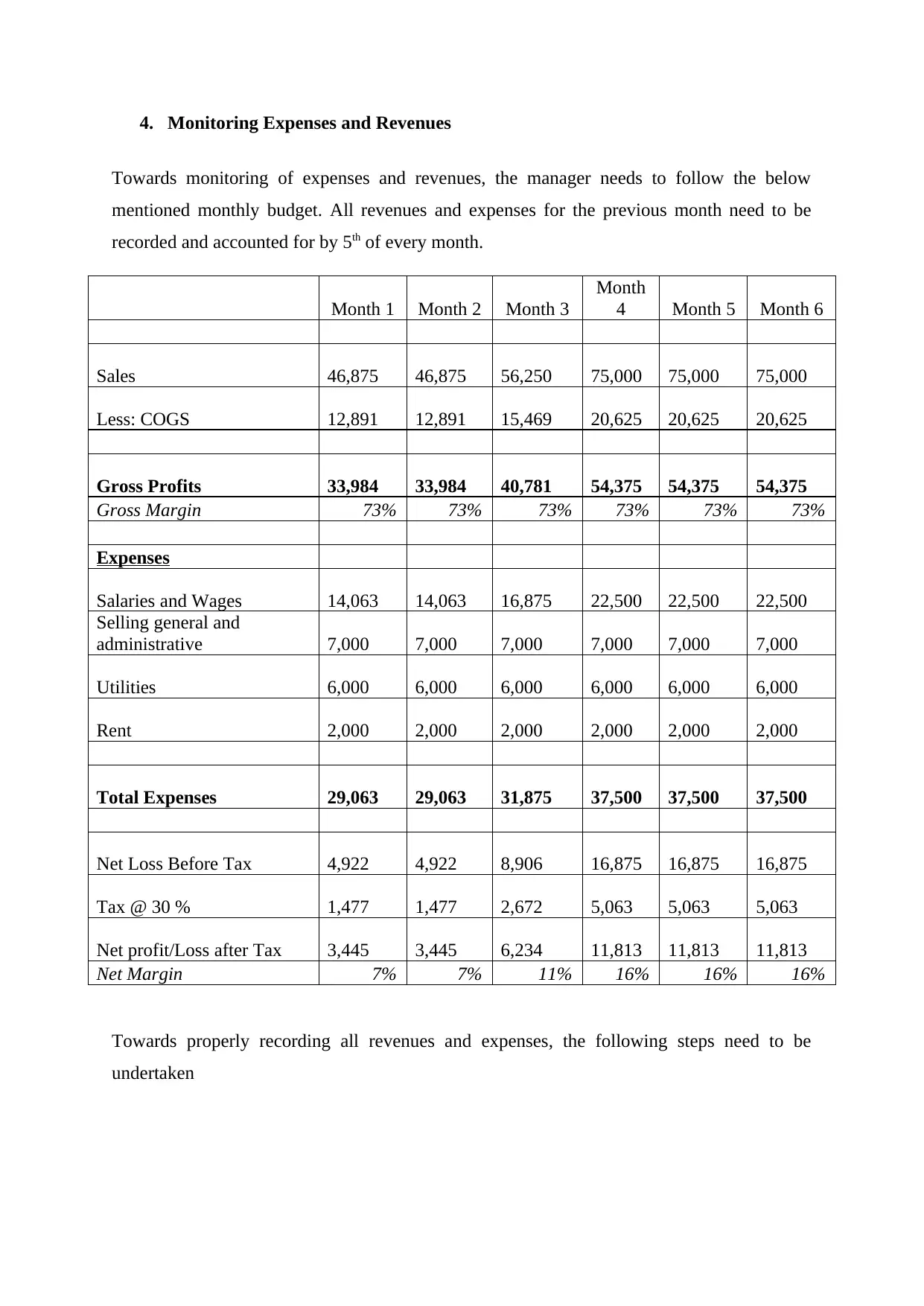
4. Monitoring Expenses and Revenues
Towards monitoring of expenses and revenues, the manager needs to follow the below
mentioned monthly budget. All revenues and expenses for the previous month need to be
recorded and accounted for by 5th of every month.
Month 1 Month 2 Month 3
Month
4 Month 5 Month 6
Sales 46,875 46,875 56,250 75,000 75,000 75,000
Less: COGS 12,891 12,891 15,469 20,625 20,625 20,625
Gross Profits 33,984 33,984 40,781 54,375 54,375 54,375
Gross Margin 73% 73% 73% 73% 73% 73%
Expenses
Salaries and Wages 14,063 14,063 16,875 22,500 22,500 22,500
Selling general and
administrative 7,000 7,000 7,000 7,000 7,000 7,000
Utilities 6,000 6,000 6,000 6,000 6,000 6,000
Rent 2,000 2,000 2,000 2,000 2,000 2,000
Total Expenses 29,063 29,063 31,875 37,500 37,500 37,500
Net Loss Before Tax 4,922 4,922 8,906 16,875 16,875 16,875
Tax @ 30 % 1,477 1,477 2,672 5,063 5,063 5,063
Net profit/Loss after Tax 3,445 3,445 6,234 11,813 11,813 11,813
Net Margin 7% 7% 11% 16% 16% 16%
Towards properly recording all revenues and expenses, the following steps need to be
undertaken
Towards monitoring of expenses and revenues, the manager needs to follow the below
mentioned monthly budget. All revenues and expenses for the previous month need to be
recorded and accounted for by 5th of every month.
Month 1 Month 2 Month 3
Month
4 Month 5 Month 6
Sales 46,875 46,875 56,250 75,000 75,000 75,000
Less: COGS 12,891 12,891 15,469 20,625 20,625 20,625
Gross Profits 33,984 33,984 40,781 54,375 54,375 54,375
Gross Margin 73% 73% 73% 73% 73% 73%
Expenses
Salaries and Wages 14,063 14,063 16,875 22,500 22,500 22,500
Selling general and
administrative 7,000 7,000 7,000 7,000 7,000 7,000
Utilities 6,000 6,000 6,000 6,000 6,000 6,000
Rent 2,000 2,000 2,000 2,000 2,000 2,000
Total Expenses 29,063 29,063 31,875 37,500 37,500 37,500
Net Loss Before Tax 4,922 4,922 8,906 16,875 16,875 16,875
Tax @ 30 % 1,477 1,477 2,672 5,063 5,063 5,063
Net profit/Loss after Tax 3,445 3,445 6,234 11,813 11,813 11,813
Net Margin 7% 7% 11% 16% 16% 16%
Towards properly recording all revenues and expenses, the following steps need to be
undertaken
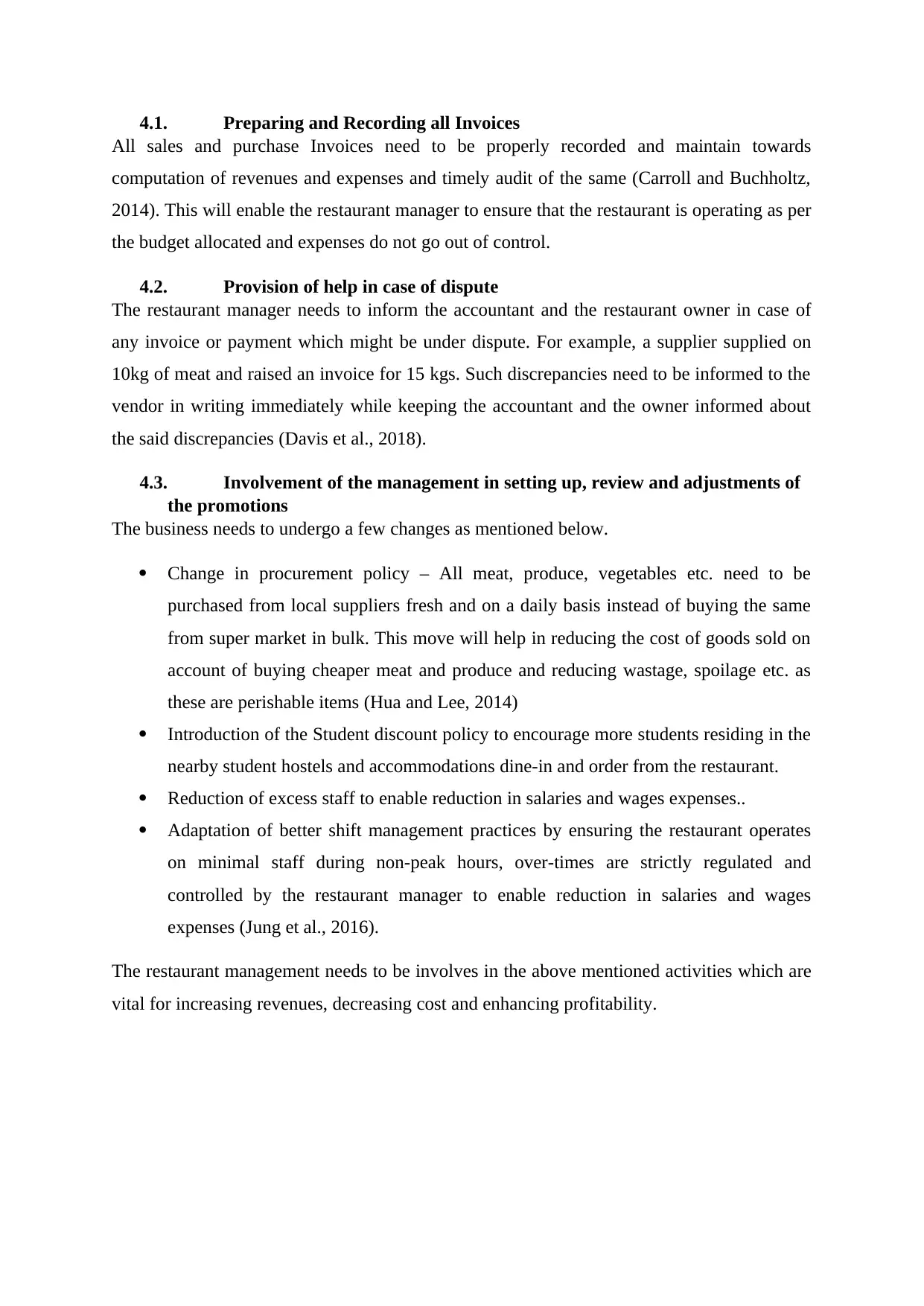
4.1. Preparing and Recording all Invoices
All sales and purchase Invoices need to be properly recorded and maintain towards
computation of revenues and expenses and timely audit of the same (Carroll and Buchholtz,
2014). This will enable the restaurant manager to ensure that the restaurant is operating as per
the budget allocated and expenses do not go out of control.
4.2. Provision of help in case of dispute
The restaurant manager needs to inform the accountant and the restaurant owner in case of
any invoice or payment which might be under dispute. For example, a supplier supplied on
10kg of meat and raised an invoice for 15 kgs. Such discrepancies need to be informed to the
vendor in writing immediately while keeping the accountant and the owner informed about
the said discrepancies (Davis et al., 2018).
4.3. Involvement of the management in setting up, review and adjustments of
the promotions
The business needs to undergo a few changes as mentioned below.
Change in procurement policy – All meat, produce, vegetables etc. need to be
purchased from local suppliers fresh and on a daily basis instead of buying the same
from super market in bulk. This move will help in reducing the cost of goods sold on
account of buying cheaper meat and produce and reducing wastage, spoilage etc. as
these are perishable items (Hua and Lee, 2014)
Introduction of the Student discount policy to encourage more students residing in the
nearby student hostels and accommodations dine-in and order from the restaurant.
Reduction of excess staff to enable reduction in salaries and wages expenses..
Adaptation of better shift management practices by ensuring the restaurant operates
on minimal staff during non-peak hours, over-times are strictly regulated and
controlled by the restaurant manager to enable reduction in salaries and wages
expenses (Jung et al., 2016).
The restaurant management needs to be involves in the above mentioned activities which are
vital for increasing revenues, decreasing cost and enhancing profitability.
All sales and purchase Invoices need to be properly recorded and maintain towards
computation of revenues and expenses and timely audit of the same (Carroll and Buchholtz,
2014). This will enable the restaurant manager to ensure that the restaurant is operating as per
the budget allocated and expenses do not go out of control.
4.2. Provision of help in case of dispute
The restaurant manager needs to inform the accountant and the restaurant owner in case of
any invoice or payment which might be under dispute. For example, a supplier supplied on
10kg of meat and raised an invoice for 15 kgs. Such discrepancies need to be informed to the
vendor in writing immediately while keeping the accountant and the owner informed about
the said discrepancies (Davis et al., 2018).
4.3. Involvement of the management in setting up, review and adjustments of
the promotions
The business needs to undergo a few changes as mentioned below.
Change in procurement policy – All meat, produce, vegetables etc. need to be
purchased from local suppliers fresh and on a daily basis instead of buying the same
from super market in bulk. This move will help in reducing the cost of goods sold on
account of buying cheaper meat and produce and reducing wastage, spoilage etc. as
these are perishable items (Hua and Lee, 2014)
Introduction of the Student discount policy to encourage more students residing in the
nearby student hostels and accommodations dine-in and order from the restaurant.
Reduction of excess staff to enable reduction in salaries and wages expenses..
Adaptation of better shift management practices by ensuring the restaurant operates
on minimal staff during non-peak hours, over-times are strictly regulated and
controlled by the restaurant manager to enable reduction in salaries and wages
expenses (Jung et al., 2016).
The restaurant management needs to be involves in the above mentioned activities which are
vital for increasing revenues, decreasing cost and enhancing profitability.
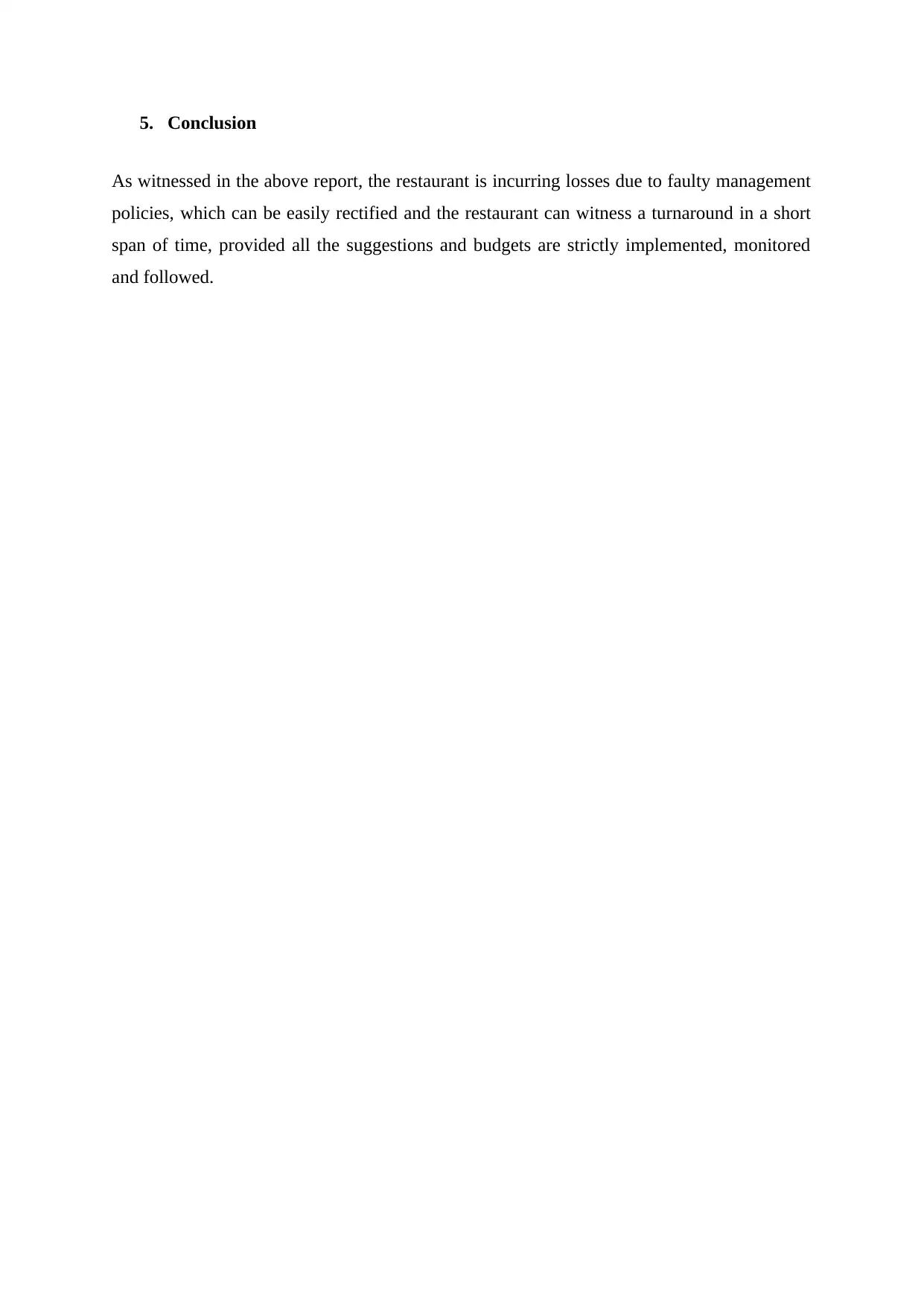
5. Conclusion
As witnessed in the above report, the restaurant is incurring losses due to faulty management
policies, which can be easily rectified and the restaurant can witness a turnaround in a short
span of time, provided all the suggestions and budgets are strictly implemented, monitored
and followed.
As witnessed in the above report, the restaurant is incurring losses due to faulty management
policies, which can be easily rectified and the restaurant can witness a turnaround in a short
span of time, provided all the suggestions and budgets are strictly implemented, monitored
and followed.
Secure Best Marks with AI Grader
Need help grading? Try our AI Grader for instant feedback on your assignments.
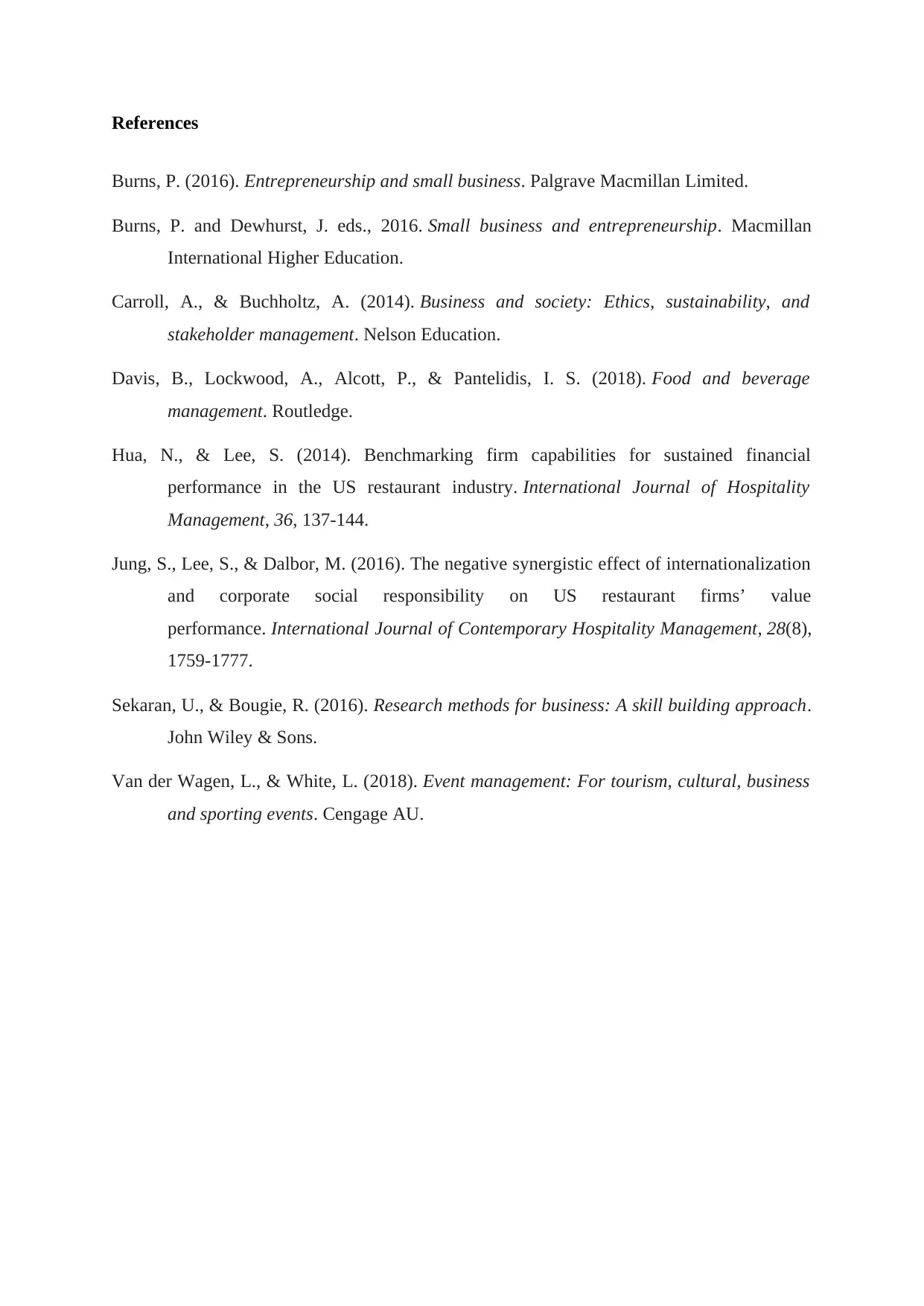
References
Burns, P. (2016). Entrepreneurship and small business. Palgrave Macmillan Limited.
Burns, P. and Dewhurst, J. eds., 2016. Small business and entrepreneurship. Macmillan
International Higher Education.
Carroll, A., & Buchholtz, A. (2014). Business and society: Ethics, sustainability, and
stakeholder management. Nelson Education.
Davis, B., Lockwood, A., Alcott, P., & Pantelidis, I. S. (2018). Food and beverage
management. Routledge.
Hua, N., & Lee, S. (2014). Benchmarking firm capabilities for sustained financial
performance in the US restaurant industry. International Journal of Hospitality
Management, 36, 137-144.
Jung, S., Lee, S., & Dalbor, M. (2016). The negative synergistic effect of internationalization
and corporate social responsibility on US restaurant firms’ value
performance. International Journal of Contemporary Hospitality Management, 28(8),
1759-1777.
Sekaran, U., & Bougie, R. (2016). Research methods for business: A skill building approach.
John Wiley & Sons.
Van der Wagen, L., & White, L. (2018). Event management: For tourism, cultural, business
and sporting events. Cengage AU.
Burns, P. (2016). Entrepreneurship and small business. Palgrave Macmillan Limited.
Burns, P. and Dewhurst, J. eds., 2016. Small business and entrepreneurship. Macmillan
International Higher Education.
Carroll, A., & Buchholtz, A. (2014). Business and society: Ethics, sustainability, and
stakeholder management. Nelson Education.
Davis, B., Lockwood, A., Alcott, P., & Pantelidis, I. S. (2018). Food and beverage
management. Routledge.
Hua, N., & Lee, S. (2014). Benchmarking firm capabilities for sustained financial
performance in the US restaurant industry. International Journal of Hospitality
Management, 36, 137-144.
Jung, S., Lee, S., & Dalbor, M. (2016). The negative synergistic effect of internationalization
and corporate social responsibility on US restaurant firms’ value
performance. International Journal of Contemporary Hospitality Management, 28(8),
1759-1777.
Sekaran, U., & Bougie, R. (2016). Research methods for business: A skill building approach.
John Wiley & Sons.
Van der Wagen, L., & White, L. (2018). Event management: For tourism, cultural, business
and sporting events. Cengage AU.
1 out of 11
Related Documents
Your All-in-One AI-Powered Toolkit for Academic Success.
+13062052269
info@desklib.com
Available 24*7 on WhatsApp / Email
![[object Object]](/_next/static/media/star-bottom.7253800d.svg)
Unlock your academic potential
© 2024 | Zucol Services PVT LTD | All rights reserved.





